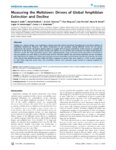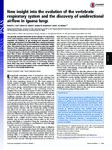|
|
Creator | Title | Description | Subject | Date |
| 1 |
 |
Sekercioglu, Cagan | Measuring the meltdown: drivers of global amphibian extinction and decline | Habitat loss, climate change, over-exploitation, disease and other factors have been hypothesised in the global decline of amphibian biodiversity. However, the relative importance of and synergies among different drivers are still poorly understood. We present the largest global analysis of roughly ... | | 2008-01-01 |
| 2 |
 |
Sekercioglu, Cagan | The worldwide variation in avian clutch size across species and space | Traits such as clutch size vary markedly across species and environmental gradients but have usually been investigated from either a comparative or a geographic perspective, respectively. We analyzed the global variation in clutch size across 5,290 bird species, excluding brood parasites and pelagic... | | 2008-01-01 |
| 3 |
 |
Seger, Jon | Natural history and evolution of paper-wasps | Paper-wasps occupy a special place in the history of animal behavior. Temperate species o f Polistes are large, beautiful, intelligent, adaptable, easy to observe, and thoroughly committed to social life. They are also aptly named, being intensely political, in the limited sense that any nonhuman an... | Individuals; Excellent; Phylogeny | 1997 |
| 4 |
 |
Clayton, Dale H. | Coevolutionary history of ecological replicates: comparing phylogenies of wing and body lice to Columbiform hosts | Phylogenies depict the history of speciation for groups of organisms. Comparing the phylogenies of interacting groups can reveal instances of tandem speciation, or "cospeciation" (Brooks and McLennan, 1991; Hoberg et al., 1997; Paterson and Gray, 1997). Understanding the conditions under which cosp... | Feather lice; Wing lice; Body lice; Cospeciation | 2003 |
| 5 |
 |
Clayton, Dale H.; Rogers, Alan R. | Genetic analysis of lice supports direct contact between modern and archaic humans | Parasites can be used as unique markers to investigate host evolutionary history, independent of host data. Here we show that modern human head lice, Pediculus humanus, are composed of two ancient lineages, whose origin predates modern Homo sapiens by an order of magnitude (ca. 1.18 million years). | Pediculus humanus; Head lice; Molecular phylogeny; Phthirus | 2004 |
| 6 |
 |
Clayton, Dale H. | Ecological basis of coevolutionary history | Macroevolutionary patterns are difficult to interpret because they are the product of a time scale so vast that deterministic and chance events are hard to distinguish. Although the macroevolutionary history of a group can be reconstructed from extant species, determining the ecological context in ... | | 2003 |
| 7 |
 |
Seger, Jon | Evolution of individuality by Leo W. Buss | Metazoans seldom reproduce vegetatively; they often die of cancer; and they almost always sequester their germ lines. Plants often reproduce vegetatively, seldom die of cancer, and almost never sequester a germ line. Buss argues that these and many other patterns can all be understood in a unified w... | Cell lines; Hierarchy; Biology | 1988 |
| 8 |
 |
Rogers, Alan R.; Harpending, Henry C. | Genetic structure of ancient human populations | Discusses mitochondrial DNA (mtDNA) sequences as important source of data about the history of human species. | Tree of descent; Mismatch distributions; Simulations; Findings; Intermatch distributions; Younger and older populations | 2001-09-15 |
| 9 |
 |
Seger, Jon | Solitary wasps: behavior and natural history by Kevin M. O'Neill | Most species of living things are insects, and ter- restrial ecology consists largely of interactions between insects and plants. The biologies of major insect groups such as Hymenoptera should be well documented and well known. Amazingly, they are not. The world is awash in excellent reviews of cur... | Insects; Ecological | 2002 |
| 10 |
 |
Coley, Phyllis D. | Herbivory and defensive characteristics of tree species in a lowland tropical forest | Rate of herbivory and defensive characteristics of young and mature leaves were measured for saplings of 46 canopy tree species in a lowland tropical rain forest (Barro Colorado Island, Panama). Grazing rates were determined in the field for sample periods in the early wet, late wet, and dry seasons... | Fiber; Herbivory; Life history; Panama; Phenolics; Plant growth; Spatial distribution; Tannins; Temporal distribution; Treefall gaps; Tropical forest | 1983 |
| 11 |
 |
Clayton, Dale H. | Influence of bill shape on ectoparasite load in Western Scrub-Jays | Populations of the Western Scrub-Jay (Aphelocoma californica) have bills specialized for feeding in their respective habitats. Populations in oak habitat have hooked bills, whereas those in pinyon habitat have pointed bills with a reduced maxillary overhang. Work on other bird species shows that the... | Ectoparasite load; Bill shape; Aphelocoma californica | 2002 |
| 12 |
 |
Clayton, Dale H. | Neotropical tineidae, II: biological notes and descriptions of two new moths phoretic on spiny pocket mice in Costa Rica (Lepidoptera: Tineoidea) | Two new species of tineid moths discovered riding on the backs of two species of spiny pocket mice (Heteromyidae) in Costa Rica are described. Amydria selvae, new species, was found on Heteromys desmarestianus Gray in the rainforest at Finca La Selva and Ptilopsaltis santarosae, new species, occurr... | Neotropical Tineidae; Phoretic moths; Amydria selvae; Heteromys desmarestianus; Ptilopsaltis santarosae; Liomys salvini; Mouse moths | 1986 |
| 13 |
 |
Clayton, Dale H. | Two new species of Dennyus (Collodennyus) chewing lice (Phthiraptera: Amblycera: Menoponidae) from swiftlets (Apodiformes: Apodidae) | The new species Dennyus (Collodennyus) mimirogerorum from the Papuan swiftlet, Aerodramus papuensis (Rand), from Papua New Guinea and D. (C.) bartoni from the Philippine swiftlet, A. mearnsi (Oberholser), from the Philippines are described and illustrated. The genetic distinctiveness of these two sp... | Collodennyus; Chewing louse; Chewing lice; Swiftlets; Phthiraptera; Papuan swiftlet; Aerodramus papuensis | 2006 |
| 14 |
 |
Clayton, Dale H. | Molecular phylogeny of the dove genus Zenaida: mitochondrial and nuclear DNA sequences | We reconstructed a phylogeny for the seven species of doves in the genus Zenaida on the basis of a combined analysis of mitochondria (ND2 and cytochrome b) and nuclear (fibrinogen intron 7) DNA sequences. This phylogeny, which is completely resolved, is well supported with all nodes showing greater... | Molecular phylogeny; Dove; Nuclear DNA | 2000 |
| 15 |
 |
Ehleringer, James R.; Negus, Norman C. | Red Butte Canyon Research Natural Area: history, flora, geology, climate, and ecology | Red Butte Canyon is a protected, near pristine canyon entering Salt Lake Valley, Utah. It contains a well-developed riparian zone and a perennial stream; hillside vegetation ranges from grasslands on the lower limits to Douglas-fir and aspen stands at the upper elevations. In this paper we describe ... | Intermountain West; Grassland; Oak-maple; Plant adaptation; Red Butte Canyon Research Natural Area; Human impact | 1992 |
| 16 |
 |
Davidson, Diane W. | Ant-plant symbioses in Africa and the neotropics : history, biogeography and diversity | Symbiotic ant-plant relationships afford an excellent opportunity to analyze the effects of both historical and ecological factors on the evolution of mutualisms. Occurring in tropical forests throughout the world, all myrmecophytic plants provide food and permanent housing to ants; the ants, in t... | Ant-plant symbiosis; Africa; Neotropics; Myrmecophytes; Plant-ants | 1993 |
| 17 |
 |
Adler, Frederick R. | Deconvolution of isotope signals from bundles of multiple hairs | Segmental analysis of hair has been used in diverse fields ranging from forensics to ecology to measure the concentration of substances such as drugs and isotopes. Multiple hairs are typically combined into a bundle for segmental analysis to obtain a high-resolution series of measurements. Individua... | | 2014-01-01 |
| 18 |
 |
Adler, Frederick R. | Reply: | We appreciate the comments of Drs. Craig and Simpson and Drs. Mullins and Schwartz, and the challenge they raise to make MALD more believable, comprehensible, and usable. Acetaminophen (APAP) toxicity is indeed a complex process involving multiple steps. Although the underlying mathematics is more i... | | 2012-01-01 |
| 19 |
 |
Cieri, Robert | New insight into the evolution of the vertebrate respiratory system and the discovery of unidirectional airflow in iguana lungs | The generally accepted framework for the evolution of a key feature of the avian respiratory system, unidirectional airflow, is that it is an adaptation for efficiency of gas exchange and expanded aerobic capacities, and therefore it has historically been viewed as important to the ability of birds ... | | 2014-11-17 |
| 20 |
 |
Coley, Phyllis D. | Rates of herbivory on different tropical trees | Rates of herbivory on marked young and mature leaves from saplings of 21 canopy tree species were measured in the wet and dry seasons. Species were classified into two life history groups: persistent species which are found throughout the shaded understory, and pioneer species which only become e... | Herbivory; Grazing damage; Tropical trees; Pioneer species; Trees -- Tropics | 1982 |
| 21 |
 |
Ehleringer, James R.; Belnap, Jayne | Sensitivity of the Colorado plateau to change: climate, ecosystems, and society | The Colorado Plateau is located in the interior, dry end of two moisture trajectories coming from opposite directions, which have made this region a target for unusual climate fluctuations. A multidecadal drought event some 850 years ago may have eliminated maize cultivation by the first human settl... | Colorado Plateau; Biological crust; Climate change; Megadrought; Ranching; Dry crop productivity; Extractive industries; Pueblo Indians; Fremont culture | 2008 |
| 22 |
 |
Clayton, Dale H.; Bush, Sarah Elizabeth | Comparative transmission dynamics of competing parasite species | Competition-colonization trade-off models explain the coexistence of competing species in terms of a trade-off between competitive ability and the ability to colonize competitor-free patches of habitat. A simple prediction of these models is that inferior competitors will be superior dispersers. Thi... | Bird lice; Campanulotes compar; Coexistence; Colonization; Columba livia; Columbicola columbae; Competition; Dispersal; Parasite; Phoresis; Specificity; Pseudolynchia canariensis; Phthiraptera | 2008 |
| 23 |
 |
Clayton, Dale H. | Molecular phylogeny of the dove genera Streptopelia and Columba | Evolutionary history of the dove genus Streptopelia has not been examined with rigorous phylogenetic methods. We present a study of phylogenetic relationships of Streptopelia based on over 3,600 base pairs of nuclear and mitochondrial gene sequences. | Doves; Streptopelia; Columba | 2001 |
| 24 |
 |
Clayton, Dale H. | Biology, ecology, and evolution of chewing lice | Chewing lice are small, dorsoventrally compressed insects and are parasites of virtually all birds (Fig. 1) and some mammals (Fig. 2). Many chewing lice are host specific, being found on only a single species of host. All chewing lice are permanent ectoparasites and complete their entire life c... | Chewing lice | 2003 |
| 25 |
 |
Bohs, Lynn A. | Phylogeny and provisional classification of the Solanaceae based on chloroplast DNA | A phylogenetic analysis of the Solanaceae based on chloroplast DNA variation is presented. Restriction site maps were determined for 79 species (52 genera) for 11 restriction enzymes. | rbcL; ndhF; Chloroplast DNA | 1999 |

























